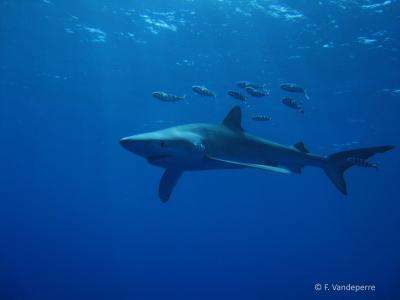Young blue sharks use central North Atlantic nursery

Blue sharks may use the central North Atlantic as a nursery prior to males and females moving through the ocean basin in distinctly different patterns, according to a study published August 13, 2014 in the open-access journal PLOS ONE by Frederic Vandeperre from University of the Azores, Portugal, and colleagues.
Shark populations typically organize by location and separate by sex and size, but these patterns remain poorly understood, particularly for exploited oceanic species such as the blue shark. The authors of this study employed a long-term electronic tagging experiment to investigate the migratory patterns of blue shark, to investigate how these population patterns change across the species' life history, as well as to assess the existence of a nursery area in the central North Atlantic. Scientists tracked about 35 blue sharks from different life stages for periods of up to ~1,000 days, as they swam through large parts of the ocean basin.
The blue sharks' movement varied individually, but the researchers found patterns and differences in movements and space use throughout the sharks' life. Specifically, they discovered evidence for the existence of a discrete central North Atlantic nursery, where juvenile sharks reside for at least 2 years. After living in the nursery, male and female blue sharks spatially separate: juvenile females seasonally migrated until they shifted toward living in tropical latitudes as they approached maturity, and juvenile males generally expanded their range southward and displayed greater behavioral variation. The authors suggest these results have implications for the sustainable management of this heavily exploited shark, especially in the central North Atlantic, where the presence of a nursery and seasonal overlap and alternation of different life stages coincides with a high fishing mortality.
"For the first time, this study shows the utilisation of a discrete, oceanic nursery in an oceanic shark and how movements change throughout their lives. It offers a unique insight in the ecological adaptations to their open ocean habitat and highlights the challenges for their management," Frederic Vandeperre added.
More information: Vandeperre F, Aires-da-Silva A, Fontes J, Santos M, Serrao Santos R, et al. (2014) Movements of Blue Sharks (Prionace glauca) across Their Life History. PLoS ONE 9(8): e103538. DOI: 10.1371/journal.pone.0103538
Journal information: PLoS ONE
Provided by Public Library of Science




















